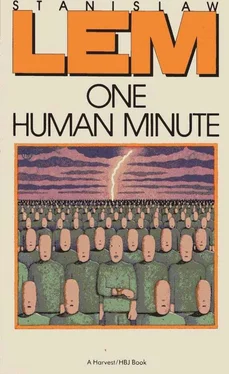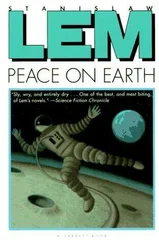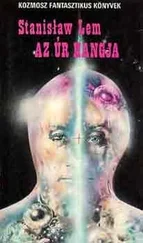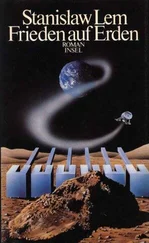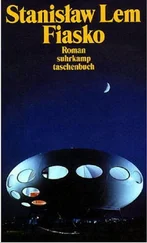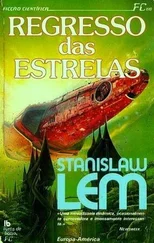When there is no longer any difference between natural and artificial protein, or between natural and artificial intelligence — say the theoreticians of knowledge, the philosophers — then neither can one distinguish a misfortune that is intentional from one for which no one is to blame.
As light, pulled irresistibly into the heart of a stellar black hole, cannot escape that gravitational trap, so humanity, pulled by the forces of mutual antagonism into the heart of matter’s secrets, fell into the trap of technology, a trap of its own making. The decision to invest everything in new weapons was not made by governments, statesmen, generals, corporate interests, or pressure groups, but by the ever-growing fear that someone else would be first to hit upon the discoveries and technologies affording the ultimate advantage. This paralyzed traditional politics. The negotiators at summit meetings could not negotiate, because their willingness to relinquish a new weapon would only indicate, in the eyes of the other side, that they had another, newer weapon up their sleeve…
By now the impossibility of disarmament had been proved mathematically. I have seen the mathematical model of the so-called general theory of conflicts; it shows why arms talks cannot produce results. At summit meetings certain decisions are reached. But when it takes longer to reach a decision promoting peace than it does to develop the kind of military innovations that radically change the very situation under negotiation, then any decision, at the moment of its acceptance, is an anachronism.
It is as if the ancients had debated so long about banning their “Greek fire” that by the time they agreed to ban it, Berthold Schwarz had appeared with his gunpowder. When one decides “today” about something that existed “yesterday,” the decision moves from the present into the past and thereby becomes an empty game.
It was this that finally, at the end of the twenty-first century, forced the world powers into a new type of agreement, an agreement that opened up a new era in the history of the human race. But that is a subject that belongs to the twenty-second century and therefore lies outside the scope of these remarks. Later, if I am able, I will devote a separate discussion to it — describing the next chapter of general history, a remarkable chapter, in which Earth, emerging from the era of antagonisms, truly frees itself from one technological trap, but steps into another, as if her destiny is to go forever from the frying pan into the fire.
Books with titles like this one began to appear at the end of the twentieth century, but the image of the world contained in them did not become generally known until the next century, for only then did the discoveries germinating in widely separated branches of knowledge come together into a new synthesis. That synthesis — to put it bluntly — marked an anti-Copernican revolution in astronomy, in which our notion of the place we occupy in the Universe was stood on its head.
Pre-Copernican astronomy put the Earth in the center of the world; Copernicus deposed it from its privileged position when he discovered that ours is but one of many planets orbiting the Sun. Over the centuries, advances in astronomy strengthened the Copernican hypothesis, showing that not only was Earth not the central body in the solar system but that the system itself was located on the periphery of our Galaxy, the Milky Way. We lived “nowhere in particular” in the Universe, in a stellar suburb.
Astronomy studied the evolution of the stars, biology the evolution of life on Earth; and the paths of their investigations met — or, rather, converged like two tributaries of a river. Astronomy took for its province the question of the incidence of life in the Universe, and theoretical biology lent its assistance to the task. Thus, in the middle of the twentieth century, CETI (Communication with Extraterrestrial Intelligence) came into being, the first program dedicated to the search for other civilizations.
But the search, conducted for several decades, utilizing ever better and more powerful instruments, found no alien civilization or any trace of a radio signal. So arose the enigma of the silentium universi. The “cosmic silence” received some publicity in the seventies, when it was taken up by the media. The undetectability of “other intelligences” was incomprehensible to scientists. The biologists had already determined what physical-chemical conditions facilitated the emergence of life from inert matter — and the conditions were not at all exceptional. The astronomers proved the existence of numerous planets around various stars. Observations indicated that a high percentage of the stars in our Galaxy had planets. The obvious conclusion was that life arose frequently in the course of ordinary cosmic changes, that its evolution should be a natural phenomenon in the Universe, and that the crowning of the evolutionary tree with the emergence of intelligent beings likewise belonged to the normal order of things. But, over the decades, the repeated failure to receive extraterrestrial signals, despite the increasing number of observatories that joined the search, contradicted this image of a populated cosmos.
According to the science of the astronomers, biochemists, and biologists, the Universe was full of stars like the Sun and planets like the Earth; by the law of large numbers, therefore, life should be developing on innumerable globes, but radio monitoring indicated, everywhere, a dead void.
The scientists who belonged to CETI and then SETI (Search for Extraterrestrial Intelligence) created various ad hoc hypotheses to reconcile the universal presence of life with its universal silence. At first they said that the average distance between civilizations equaled fifty to a hundred light-years. Later they had to increase the distance to six hundred and then to a thousand light-years. And there were hypotheses about the self-destructiveness of intelligence — such as von Hörner’s, which connected the psychozoic “density” of the Universe with its barrenness, claiming that suicide threatened every civilization, as nuclear war was now threatening humanity. The organic evolution of life took billions of years, but its final, technological phase lasted barely a few dozen centuries. Other hypotheses pointed to the dangers that the twentieth century encountered even in the peaceful expansion of technology, whose side effects devastated the reproductive capacities of the biosphere.
Someone said, paraphrasing the famous words of Wittgenstein, “Whereof one cannot speak, thereof one must make poetry.” Perhaps Olaf Stapledon, in his fantasy Last and First Men, was the first to express our destiny, in this sentence: “The stars create man, and the stars kill him.” At the time, however, in the 1930s, these words contained more poetry than truth; they were a metaphor, not a hypothesis qualifying for citizenship in the realm of science.
But any text can hold more meaning than its author gave it. Four hundred years ago, Francis Bacon contended that flying machines were possible, as well as machines that would speed across the Earth and travel on the sea bottom. He certainly did not conceive such devices in any concrete way; but we, reading his words today, not only know that they have come true but also expand their meaning with a multitude of details familiar to us, which only adds weight to his statements.
Something similar happened with the idea that I expressed at the American-Soviet conference of CETI in Burakan in the year 1971. (My text can be found in the book Problems of CETI, published by Mir in Moscow in 1975.) I wrote then:
Читать дальше
